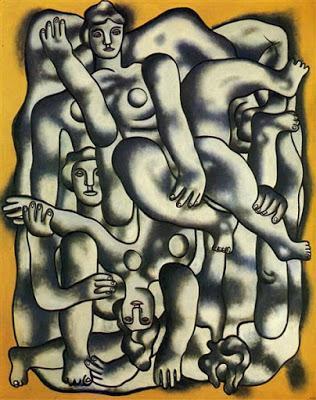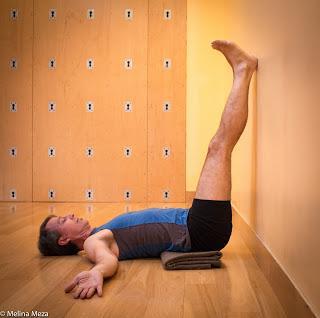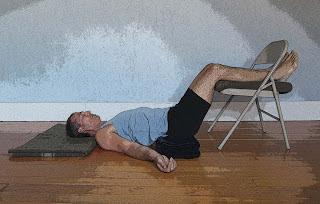
Acrobats in Gray by Fernand Leger*
Q: I am working with a new student, in class and privately, that suffers from severe restless leg syndrome (RLS). She is on heavy medications (1 is a Parkinson’s drug) and is just starting a yoga practice. She is 70, a little bit over weight and wants to lose some weight. She is very sharp, great attitude, lovely person. She has had RLS for at least 20 years. She does get leg / foot cramps frequently. Do you have any practices and / or advice for working with people that suffer from this advanced condition?I'm thinking Reclined Leg Stretches, Hands up the wall (Yoga Glue) and Legs up the Wall could be part of her regular practice. Thanks for any help you can send my way.
A: Let's start by taking a look at what restless leg syndrome (RLS) is and how it affects people who have the condition. Then I'll discuss how yoga can help.
Basically restless leg syndrome is a condition that affects your lower legs and sometimes your feet and upper legs (and, more rarely, your arms). When you have this condition, you experience uncomfortable sensations in your limbs that cause you to feel an urgent need to move them. The movement actually relieves the uncomfortable sensations, but only temporarily and sometimes only partially. People describe the sensations in their legs in many different ways, including cramping, tingling, crawling, aching, pulsating, and burning, to name a few. Episodes can last for as long as an hour.
The symptoms are most common at night, when they can cause disrupted sleep patterns. These disrupted sleep patterns can in turn cause other negative effects, including daytime drowsiness and trouble concentrating, and over time can contribute to the development of depression, anxiety, and cognitive decline. But for most people the symptoms can also occur when you are sitting still for longer periods, which can make any situation where you have to sit (such as for car or plane travel, meetings, and performances) very challenging.
The condition becomes more common with age, is more prevalent in women, and is worsened by stress. Restless leg syndrome is also more commonly seen in people with other health issues, such as diabetes, kidney disease, cardiovascular disease, and pregnancy. And the use of caffeine and some prescriptions drugs, such as lithium, calcium channel blockers and some seizure medications, can increase the risk of getting restless leg syndrome.
There is no known cure for this condition, but western treatments include medications to address sleep, pain, and numbness, and, of importance to us, relieving stress and stretching the leg muscles as a way to reduce symptoms. Therefore, doing movement practices, such as yoga, on a regular basis, may help relieve symptoms and diminish their frequency. In fact, a 2013 study Efficacy of an Eight-Week Yoga Intervention on Symptoms of Restless Legs Syndrome (RLS): A Pilot Study looked at the use of gentle yoga for restless leg syndrome and concluded:
“These preliminary findings suggest that yoga may be effective in attenuating restless leg syndrome symptoms and symptom severity, reducing perceived stress, and improving sleep and mood in women with RLS.”
Although it is not possible to know for sure if your new student’s yoga practice will help her restless leg syndrome, if she uses her practice both to manage her stress levels and to stretch and move her legs and hips, yoga may indeed have a positive impact on her symptoms over time. And the poses you suggested above are definitely a good start.
With that in mind, I have some general recommendations for how to approach this condition.
First, I recommend that you gently stretch all the basic muscle groups in your legs and hips. For this purpose, all the basic standing poses are helpful if you do them in a gentle way, moving dynamically or just staying in the poses for short periods of time. To target your legs, some of the most effective leg stretches are the four versions of Reclined Leg Stretch LINK. To stretch your calves, try practicing Warrior 1 with your hands on a wall, which will provide a good stretch for the calf of your back leg. To stretch your hips as well as your legs, try my dynamic sequence Dynamic Reclined Hip Stretches.
To reduce stress while also releasing leg tension, I recommend Legs Up the Wall pose (Viparita Karani) and Easy Inverted pose (Relaxation pose or Viparita Karani with your legs on a chair, with or without a folded blanket under your pelvis).



For more ideas on stress management, check out our post:
Stress Management for When You're Stressed
For more ideas on yoga for better sleep, check our posts:
Day to Night: Yoga for Better Sleep
Five Tips for Better Sleep
—Baxter
Subscribe to Yoga for Healthy Aging by Email ° Follow Yoga for Healthy Aging on Facebook ° Join this site with Google Friend Connect

